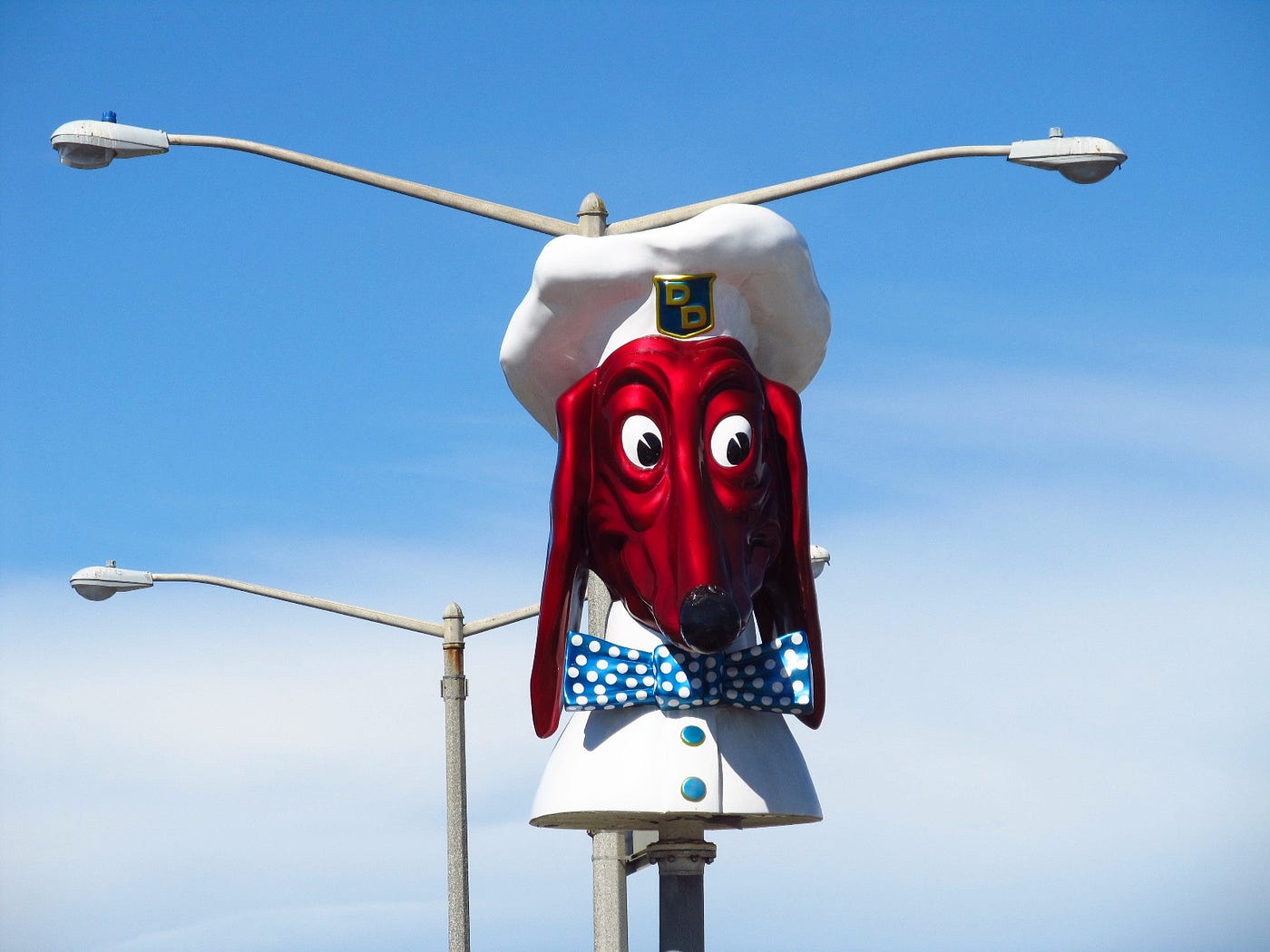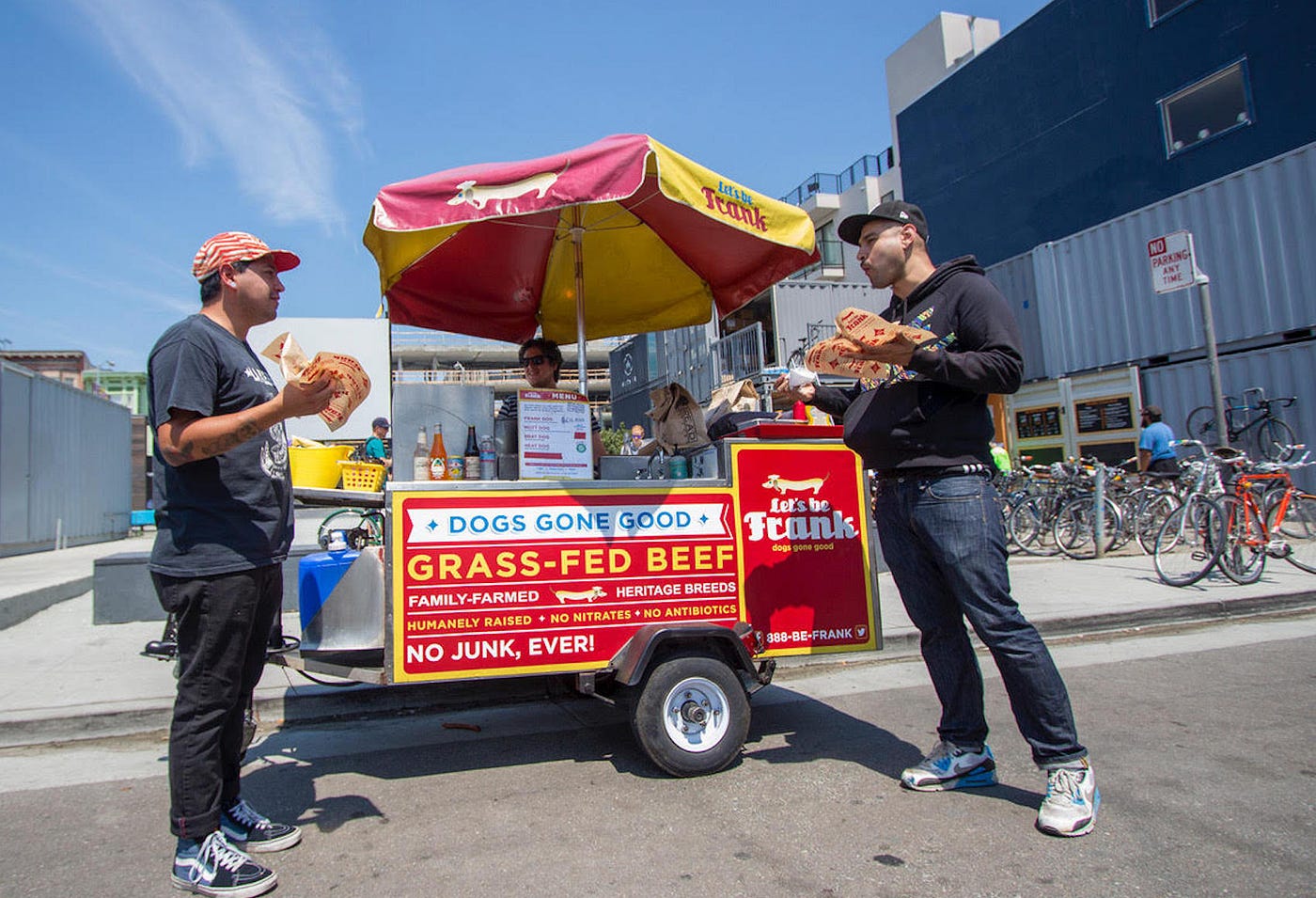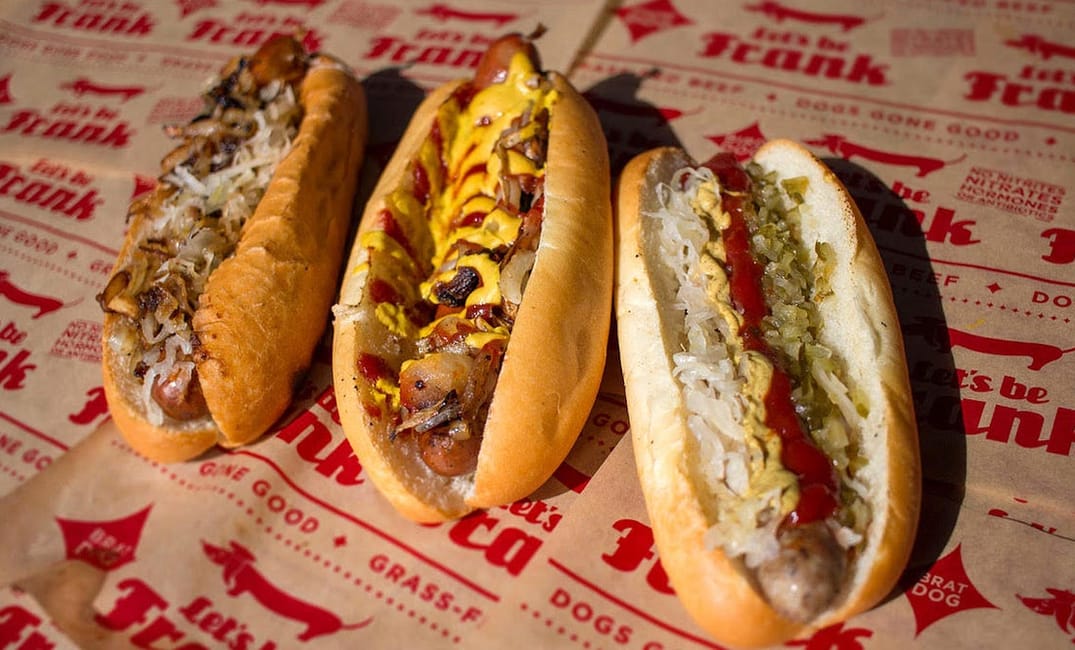
San Francisco has been the epicenter of many culinary creations, from cioppino to chop suey. It’s also the city that supersized the burrito, perfected sourdough bread, and introduced the country to dim sum. But there’s one food that falls epically short here, and that’s hot dogs.
At last count, San Francisco had 4,415 restaurants. A Yelp search for pizza yields more than 1,500 results; a similar query for burgers results in about the same number. There are currently 15 — count ’em, 15! — Burmese establishments, as well as a new restaurant dedicated entirely to the food of the Malaysia’s Mamak people. But after searching for hot dog joints, including street stalls and late-night carts with erratic schedules, I was able to verify only a dozen or so. That’s a stark contrast to the numerous corner hot dog stands in most major metro hubs.
Thanks to a survey by the National Hot Dog and Sausage Council, statistics support my claim that when it comes to our appetite for hot dogs — one of the most consumed foods in America — San Francisco doesn’t hold up next to the country’s other big cities. At 31 million pounds per year, Los Angeles consumes the most franks, followed by New York City, Philadelphia, Boston, and Chicago. Some surprising second-tier cities, such as Tampa and Atlanta, can hold their own too. Meanwhile, San Francisco doesn’t even crack the top 10.
In some cities, nothing will incite more drama than a conversation about how a hot dog should be served. New Yorkers will always want their dirty-water dogs with mustard and sauerkraut. Seattleites will try to convince you that cream cheese has its place between a bun. Just try to put ketchup on a hot dog in Chicago, and you’ll discover the end of the world. But watch people take on the condiments section at a hot dog stand in San Francisco, and you’ll realize that everything from ketchup to mustard to sweet relish to mayonnaise (mayonnaise!) is fair game. There are no allegiances and no deep divides. What gives?
“I thought we were going to sell a ton of hot dogs, but people would just walk by. We started grilling onions just to get people to stop.” —Sue Moore, Let’s Be Frank
By all accounts, San Francisco should have a rich hot dog culture. To get to the bottom of this, I headed to the archives of the San Francisco History Center. It turns out that frankfurters as we know them date as far back as the 15th century in Germany or Austria, but the story behind the name “hot dog” is far less clear. While there are debated origin stories about hot dogs in America, two famous accounts were said to have taken place in San Francisco, according to a 1981 letter from the pseudo-legal San Francisco Court of Historical Review to superior judge Harry Low.
One account is that Yao Wen-yuan, a Chinese cook on the railroads in the 1860s, served workers a bun filled with duck and called it “hot duck.” Another version dates back to the late 1890s, when U.S. government officials — according to this theory — brought the Igorot tribe from the Philippines to San Francisco for an exhibition and set up camp for them at 8th and Market Streets. Canines were part of the Igorots’ food supply, and when they found themselves short, they raided the nearby Mission District for dogs, prompting an outcry in the neighborhood over stolen—or “hot”—dogs. The tribe was later sent to St. Louis for the 1904 World’s Fair. To appeal to the spectators lined up to ogle the villagers cooking and eating dog, food vendors sold frankfurters as “hot dogs.”
However it got its start, by the 1920s, the dish had become famous throughout America, and its name altered to “hot dog,” with ingredients tweaked for local palates.
Hot dog mania arguably reached its peak in San Francisco in the 1960s, thanks to Doggie Diner, a local chain with made-to-order hot dogs that’s now best remembered for its sign, which depicts a red dachshund bearing saggy jowls and a chef hat. At the company’s peak, more than a dozen “Doggies” dotted San Francisco, with 33 across the Bay Area. A location at Golden Gate and Van Ness was the site of the so-called World’s Hot Dog Eating Championships, according to a San Francisco Chronicle article from December 13, 1968.
When the last of the Doggies closed in 1986, citing competition from companies like McDonald’s, the San Francisco Chronicle declared it the “End of an Epicurian [sic] Era.” Recently, there’s been talk of reviving the diner, but if and when that might happen is unclear. Napa resident Kip Atchley secured one of the Doggie signs, acquired the chain’s trademark rights, drafted business plans, and secured a location — that is, until an investor pulled out of the project after losses attributed to the 2016 Lake County fire, the Chronicle reported.

For now, all that remains of Doggie Diner are the 30-odd signs, many of them with Bay Area antiques shops and collectors. The last doggie head that can be seen standing in San Francisco is now a city landmark at Sloat Boulevard and 45th Avenue, a reminder of the city’s most sausage-loving era.
One reason for the downfall of the hot dog? The farm-to-table movement.
Around the same time when Doggie Diners hit peak popularity, another kind of food trend was gaining ground on the other side of the Bay. Alice Waters and her restaurant, Chez Panisse, were ground zero for the movement that would come to define San Francisco’s modern food scene. Today, it’s virtually impossible for anyone living in Northern California to dine or cook without a heightened awareness of where their food comes from. Traditional hot dogs, however, have a bad rap for standing on the opposite end of the spectrum. One recent poll reported that 43% of Americans don’t know what’s in their hot dog — and are afraid to find out.
I asked an industry veteran if the wiener’s bad rap had anything to do with the dearth of hot dog stands in San Francisco. “In California, people are health-conscious, and just because of that, they kind of put hot dogs at the bottom of the list,” said Sue Moore, co-owner of the hot dog cart and catering business Let’s Be Frank.

Moore, who was Waters’ former “meat forager” at Chez Panisse, wanted to end that stigma when she co-founded the grass-fed-beef hot dog company in 2005. But despite her sustainable food ethos, it was still hard to sell hot dogs to locals, even during baseball games at the ballpark. “I thought we were going to sell a ton of hot dogs, but people would just walk by. We started grilling onions just to get people to stop.”
There’s also the cost of doing business here. Businesses have to contend with the fact that San Francisco rents are some of the highest in the country, and hourly labor costs more than twice the national rate—and that’s before factoring in added line items such as benefits. These factors, in combination with the hot dog’s low price point, make doing business exceptionally difficult for hot dog operators.
“There is no really vibrant hot dog culture in the city, nothing like Chicago, New York, Detroit, or even L.A.”
— Bruce Kraig, hot dog historian
“The margin is really, really difficult,” Moore said. “People expect hot dogs to be cheap. They don’t mind paying more for sausage, but to be honest, a sausage is easier to make than a hot dog. Making a hot dog, particularly ours — which is all grass-fed, no dairy, no soy, no filler — is very expensive.”
And despite its walkability, the city may not be dense enough to support a volume required for a strong street-cart culture. Let’s Be Frank opened a storefront in the Marina in 2009, only to close four years later because of challenges that came with insufficient foot traffic.
But all these factors may be just the veritable ketchup on the hot dog. The real meat of the matter likely comes down to this: San Franciscans simply don’t have a strong sausage heritage.
Julie Walton, a California native and owner of the new Grem’s Good Dog, admitted that she grew up thinking that sausages were just something to be eaten at breakfast. “It’s not really on your mind. But in the same way, you don’t find a million burrito places in New York or Chicago, because culturally, that’s not who’s been there.”
Moore agreed. “[Sausage] culture doesn’t exist in San Francisco because it’s not the makeup of the population,” she said. “There are so many people that live in San Francisco that didn’t grow up in San Francisco, so that strong point of view gets diluted.”
But not everyone I raised this debate with took that stance. In fact, Andrew Ghetia, an owner and operator of 4505 Burgers & BBQ, firmly disagreed with me, citing the Bay Area’s late-night hot-dog-cart culture.

“I don’t think anyone who’s been to a Warriors game at the Coliseum and walked out of the BART station to the smell of bacon-wrapped hot dogs cooking in the tunnel while vendors hawk the latest and greatest in bootleg Warriors jerseys could say the Bay Area doesn’t have a hot dog culture,” Ghetia said. “You won’t find it on Yelp or a brick-and-mortar storefront in the Financial District, but I think anyone who’s stumbled out of Doc’s Clock after last call will agree that there’s nothing more welcoming than the smell of onions and peppers grilling on a sheet tray while bacon-wrapped dogs sizzle next to ’em.”
For a more macro perspective, I also turned to the country’s preeminent hot dog historian—Bruce Kraig, professor emeritus of history at Roosevelt University and author of Hot Dog: A Global History and Man Bites Dog: Hot Dog Culture in America. “You’re right. There is no really vibrant hot dog culture in the city — nothing like Chicago, New York, Detroit, or even L.A.,” he said.
“Without more research, I’d say that class and pricing likely accounted for the lack of a hot dog culture,” he also added, citing popular hot dog spots in other parts of the Bay Area, like Caspers Hotdogs, a chain with eight locations in the East Bay but none in the city of San Francisco. He also suggested that one of the reasons why street vendors might have largely disappeared could be strict city ordinances.
Meanwhile, Grem’s, Walton’s new drive-through and walk-up hot dog stand, has been open for only six months, but she’s been blown away by the volume of feedback she’s received. “I kept getting people coming through the drive-through being like, ‘I can’t believe we finally have a hot dog place!’ just over and over again.”
She aims to please her customer base, which includes Uber and Lyft drivers and nearby city workers, with a classic bite that’s affordable and easy to eat on the go. But she adds her own California take on the hot dog, too, sourcing half-sourdough buns from Starter Bakery in Berkeley and offering a dog that’s topped with probiotic sauerkraut and fresh arugula.
“If you come during lunch,” she tells me, “you’ll realize that there is hot dog hope in San Francisco.







